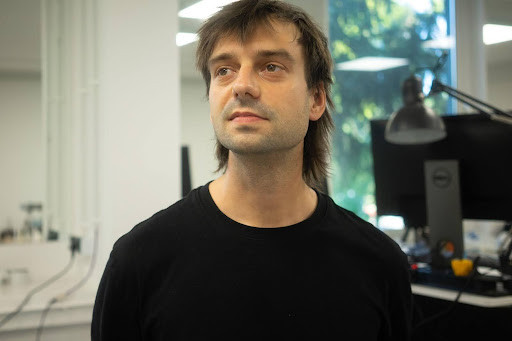From Pixels to Polymers: Crafting the Future with Wiktor Przybył and Clone

At first glance, Wiktor Przybył's résumé reads less like an engineer's dossier and more like the eclectic biography of a polymath. With degrees in Graphic Design and New Media Art from the esteemed Academies of Fine Arts in Katowice and Wrocław, Przybył's early fascination wasn't bolts and circuits, but rather the elusive "secret knowledge" of aesthetic perfection-composition, narrative, and visual storytelling. Yet, today, he applies these principles not just to canvases or screens, but to humanoid robots that could soon become integral parts of our daily routines..
The leap from art galleries to robotics labs might seem unconventional, but for Przybył, it's a result of a natural evolution. After all, good design is universal-whether you're creating a compelling animation or engineering artificial muscles to mimic human motor activity. Initially stepping into the world of industrial research and development, Przybył quickly became adept in polymer engineering, elastomer processing, and advanced additive manufacturing.
The practical experience crystalised in his innovative approach-ingeniously merging mass-production efficiency with the agility of 3D printing and algorithmic modeling that not only impressed his peers but also significantly reduced costs, accelerated project timelines, and optimized resource allocation.
Never one to shy away from innovation's frontline, Przybył contributed critical advancements to aerospace-grade manufacturing processes and showcased his custom animation software at prestigious art exhibitions, effortlessly straddling the boundary between technical precision and creative expression. His dual fluency in the languages of art and engineering allowed him to see opportunities where others saw limitations, continually pushing forward the boundaries of what's possible.
Currently, Przybył is at the core of Clone, an ambitious robotics startup under Dhanush Radhakrishnan's and Łukasz Koźlik's visionary leadershi
Their flagship creation, Protoclone, represents an astonishing leap forward in biomimicry and mechanical sophistication: a musculoskeletal structure boasting over 1,000 artificial muscle fibers, more than 500 sophisticated sensors, and over 200 degrees of freedom, enabling movements that closely replicate the fluidity and subtlety of human motion. Equipped with advanced sensory systems, Protoclone operates with an elegance and quiet grace far removed from the clunky, jerky movements traditionally associated with robots.
Yet Przybył's role at Clone extends far beyond elementary mechanical engineering. He conceptualized, designed, built and programmed custom machinery specifically to produce the artificial muscles. These unparalleled machines operate day by day with zero to minimum maintenance, demonstrating his remarkable ability to pair ingenious design with practical durability. The results of this effort didn't just speed up Clone's development cycle—they fundamentally transformed the company's capacity for rapid iteration, swift adaptation, and continuous refinement.
Przybył views robotics through a profoundly humanistic lens. "Building a humanoid is equally about mastering mechanics and decoding what truly makes us human—both aspects are essential and deeply intertwined," he emphasizes. Far from fearing robotic dominance, he envisions a future where robots handle mundane tasks, liberating humans to "pursue knowledge, practice kindness, and strengthen cooperation—making space for a better, more enlightened world."
Collaboration sits at the heart of Przybył's philosophy. He insists that "Robotics is fundamentally about teamwork-thinkers, engineers, and designers working side-by-side, guiding technology towards enhancing human lives and away from dystopian paths." His pragmatic approach to work, distilled into personal rules infused with practical wisdom and subtle humor, reflects his balanced worldview: "I always waited for the occasion to share my extraordinary observations, here they are: clearly define your problems, solve them incrementally, transcend immediate solutions for long-term gains, ask seemingly trivial questions to ensure alignment, leverage your team's passions, and significantly-don't eat trash!".
Przybył's philosophy champions interdisciplinary resilience and creative bravery. He predicts AI advancements will dismantle traditional barriers, allowing creators and engineers to concentrate exclusively on the originality and quality of their innovations. Yet, beyond technology itself, Przybył highlights passion as humanity's strongest driving force, underpinning every substantial innovation.
As Clone Robotics approaches its anticipated commercial launch in 2026, industry observers are closely watching. Positioned alongside a number of prominent competitors, Protoclone symbolizes a pivotal shift towards genuinely biomimetic robotics, designed not merely to mimic human actions, but to meaningfully augment human capability.
Wiktor Przybył's remarkable journey-from artist to innovator, storyteller to roboticist-vividly exemplifies the notion that authentic innovation thrives at the intersection of seemingly disparate fields. Through his pioneering work, Przybył not only shapes the future landscape of robotics but also encourages others to embrace creativity, bold interdisciplinary exploration, and, ultimately, the limitless potential of humanity itself.
Looking ahead, Przybył envisions robots not merely as helpers but as collaborative partners in human development. He frequently references classical ideas, such as Aristotle's thoughts on automation, illustrating how today's robotics fulfill ancient dreams of effortless assistance, enabling humans to focus on higher pursuits of intellect, art, and philosophy.
Moreover, Przybył emphasizes the role of ethics in robotics. His advocacy for responsible development highlights his commitment to technology that complements human values rather than replaces them.
© Copyright IBTimes 2025. All rights reserved.




















